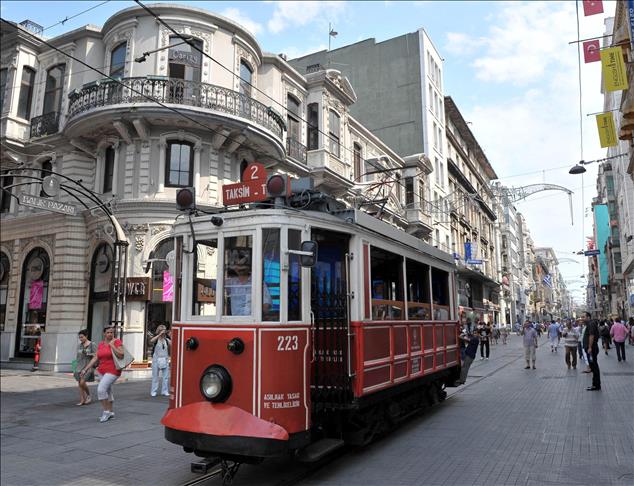
by Tuncay Kayaoglu
ISTANBUL
The Tram once the symbol of the ambition of the ruling elite of the Ottoman Empire, still serves Istanbul today. It has become a symbol not only of nostalgia in taking the visitor around historical Istanbul but it offers a modern, practical transportation alternative to cars, buses and taxis while alleviating Istanbul's congestion and pollution.
In a time of financial crises and industrial regression, the Sublime Port (the central government of the Ottoman Empire), did not hesitate to put financial resources in adopting this latest European invention. The dream was realized in 1871 and the tram continued to serve the people of Istanbul regularly until 1966. It was reintroduced in 1990 for nostalgic, if not practical reasons to adorn Istikal Caddesi, a famous pedestrian street linking Taksim and Pera.
The popularity of the tram in cities around the world travelled fast. In 1862, it was in service in London. Two years later, in 1864, a foreign company offered its services to the Ottoman government to build a tram between Galata and Besiktas and also in the historical peninsula. However, this early attempt failed mainly for practical reasons rather than from budgetary constraints. The earlier attempts had to contend with Istanbul’s narrow streets, its rough hilly terrain, as well as the legal obstacles in nationalizing private property made building a tram in Istanbul a tall order, according to transportation expert, Professor Vahdettin Engin.
Although these earlier attempts ended in failure, that did not dampen some entrepreneurs’ enthusiasm from bidding to build a tram in Istanbul. Some local companies also attempted to build it, but eventually Karapano Efendi convinced the authorities to do so with his plan in 1869.
In the same year, the authorities also gave concessions to a British company to build an underground railway between Galata and Pera (what is now known as Tunel) and a railway from the capital to former capital, Edirne. “"The Ottoman elite kept close tabs on technological inventions and believed in using them to develop the country. When Europeans built railways connecting different parts of cities and parts of the country, the Ottomans deemed it necessary to use them in Istanbul,” Engin told AA.
After two years, a tram between Galata and Besiktas was in service and this service was later extended to Ortakoy on Istanbul’s waterfront. The company also built new railways to Taksim and extended it further into Sisli, a new part of Istanbul in 1883. The tram service gradually changed to electric from a horse-drawn tram and was put into service between Taksim and Pera for the first time in 1913.
“The Tram was loved and constantly used by Ottomans. It was a symbol of Ottoman Istanbul,” Engin noted.
The Tram network reached its greatest coverage in 1956 with 270 shuttles on 56 lines. However, after that the tram service began to lose ground to other types of public transportation, eventually Istanbul’s tram service ended completely in 1966. Once a symbol of Europeanization, it was now obsolete. “It was believed that the tram was a backward mode of transportation. Thus, trolleybuses were put into service,” Engin said.
After twenty-four years, the tram service was reintroduced as a tourist attraction when popular Istiklal Street was zoned as a pedestrian street. After gaining popularity among tourists as well as natives, another heritage tramway was opened in 2003 in Kadikoy, the asian part of the city.
“The Tram is such an phenomenon that tourists do not want to leave Istanbul without getting on board. What was once a nostalgic feature of Istiklal has become a symbol of the city,” the General Director of the Istanbul Electric Tramway and Tunnel Management (IETT), Hayri Baracli, told Anadolu Agency (AA) correspondent.
Apart from transportation, the tram serves other purpose such as providing a venue for small concerts and special cultural and social activities.
The IETT will put new carriages into service, and Baracli added that the company plans English language courses for tram drivers so that they can serve tourists better.
The nostalgic tram is in service between 07.00 until 22.45 and carries around 1,500 people.
Next time you’re Taksim, get on board.
englishnews@aa.com.tr
Anadolu Agency website contains only a portion of the news stories offered to subscribers in the AA News Broadcasting System (HAS), and in summarized form. Please contact us for subscription options.

